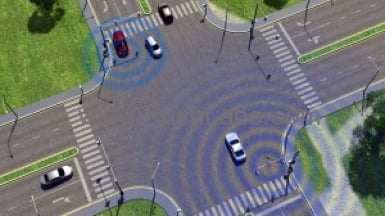Find Our Latest Video Reviews on YouTube!
If you want to stay on top of all of our video reviews of the latest tech, be sure to check out and subscribe to the Gear Live YouTube channel, hosted by Andru Edwards! It’s free!
Thursday June 2, 2011 1:09 pm
Ford to produce smart cars that warn each other of an impending collision

Ford brought a small fleet of intelligent vehicles to San Francisco to showcase a technology that the company expects will be mainstream in about five years, from most automakers.
Two Ford Focus cars and a Ford Expedition were equipped with a technology called Dedicated Short-Range Communications (DSRC), which basically serves as a car-to-car wireless connection that currently serves as a crash avoidance system in Ford's implementation, and as a wireless toll collection mechanism overseas. Eventually, it could even be used for entertainment purposes.
Although Ford demonstrated the technology in a parking lot outside of AT&T Park, the company isn't alone in developing the technology. Ford, General Motors, Nissan, Honda, Toyota, Volkswagen, Audi, Mercedes, Hyundai, and Kia are all working together, plus truck, bus, and motorcycle companies, said Mike Shulman, the technical leader in Ford's Active Safety Research and Innovation department.
"Next year, we're doing a model deployment in a city where there will be thousands of equipped vehicles and trucks and buses all sending out these messages, and then the goal in 2013 is to start a regulation that will require this on all vehicles. Then, maybe consumer electronics companies would start designing products that could be retrofitted onto existing cars, because everyone sees the potential," Shulman said.
"Maybe five years from now, cars will be equipped with this," Shulman added.
Perhaps the best thing about DSRC is its expected low cost: because it simply combines a derivative of Wi-Fi, called 802.11p, with off-the-shelf GPS radios, the cost to integrate can be really low, Shulman added.
According to Jim Buzkowski, director of electronic and electrical research for Ford, about 3.9 billion people will live in urban areas by 2030, contributing to the world's gridlock. They'll spend about a work week in their cars each year, he said.
"Ford recognizes the need for smarter or sustainable ways to move around big cities, and part of the solution is more transparent vehicle communications," Buzkowski said. DSRC could Wi-Fi and GPS to talk to each other and reduce the possibility for accidents, and also traffic jams.
Ford's not the only company to attack the traffic problem. Dutch GPS maker TomTom, for example, has made reducing traffic a priority of its connected GPS devices. And Google's self-driving car has bigger ideas: take the stress out of a commute by letting the car do all the work.
How does it work?
Currently, Ford uses a "smart intersection" in Dearborn, Mich., where an intersection transmits data to surrounding vehicles. Ford's goal right now is safety, where drivers could be quickly alerted to vehicles running a red light, for instance.
Each car communicates its speed, direction, and position about 10 times per second. Each DSRC node (which could be a car or an antenna mounted by the side of the road) can communicate between 300 to 500 meters.
"You don't want to get much greater than that," Shulman said. "The channel gets congested. You ever go to a conference room where everybody's using Wi-Fi? The bandwidth gets real slow."
Ford also allowed reporters and guests to go on rides inside the DSRC-equipped cars. When one of the car's sensors picked up a threat, such as an unexpectedly slowing car, a tone sounded and red light projected on the windshield. Ford is considering tying the DSRC sensors into the brakes and other systems, so that they could automatically slow the car in case of an emergency.
But that also means that Ford's intelligent cars would have to be "certain" before they, too, possibly caused a collision by unexpectedly slowing. That probably means that multiple sensors will have to generate a confirmation, Shulman said.
The future: bidding on parking spots
The car is now the "fifth screen," said Win Williams, vice president of AT&T Mobility and consumer markets. Williams said that there's opportunity to sell services into the car on the back of some form of connectivity, but that people aren't willing to pay for it. "The research shows its between $20 to $40" per month, for a subscription, he said. "I think the reality shows it's a lot less."
Shankar Sastri, dean of the College of Engineering at U.C. Berkeley, said he believed in a world where smart sensors in parking spots could be connected via some form of communication to the car, which could reserve or bid on a preferred parking spot before setting out on a commute.
One question that sidetracked some at the Ford event was whether the "smart intersection" could survive using just the cars itself, or whether it needed a fixed infrastructure to support it. The problem, of course, is that cash-strapped states would need to justify the expense, unless private industry stepped in. But most agreed that connecting cars would benefit automakers and consumers alike.
Thilo Koslowski, an vice president at Gartner, cited a survey his company had done that showed that younger consumers are twice as interested in Internet access as they were in the car itself, and, if forced to choose, would give up the car. "By 2016 consumers will come to expect some sort of connectivity in your vehicle," Koslowski said. "In automotive years, that's right around the corner."
This article, written by Mark Hachman, originally appeared on PCMag.com and is republished on Gear Live with the permission of Ziff Davis, Inc.











